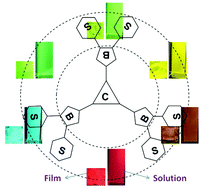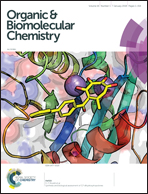Diarylmaleimide-based branched oligomers: strong full-color emission in both solution and solid films†
Abstract
Maleimide and benzene are employed as a dendron and a core, respectively, to construct two series of non-conjugate branched oligomers (B3G1 and B1G2) based on diarylmaleimide fluorophores by an alkylation reaction. Surface aryl groups are changed to tune the emissive color of branched oligomers from blue (λem = 480 nm) to red (λem = 651 nm), realizing full-color emission. The investigation on the photophysical properties of the oligomers indicates that they display intense emission in both solution and solid films, due to the suppression of intramolecular rotation and intermolecular interaction. Molecular simulation and natural transition orbital analysis show that the electron transition takes place in the individual arylmaleimide for the non-conjugate linkage of fluorophores in branched oligomers. It can avoid the unpredictability of the luminescence properties caused by the interaction of fluorophores. In addition, the good solubility, thermostability and oxidative stability of the branched oligomers make them have huge potential in the solution-processable photonic application. These results demonstrate that such a design strategy of non-conjugate branched oligomers is a very efficient and constructive method to obtain high-performance light-emitting materials in both solution and solid films.



 Please wait while we load your content...
Please wait while we load your content...